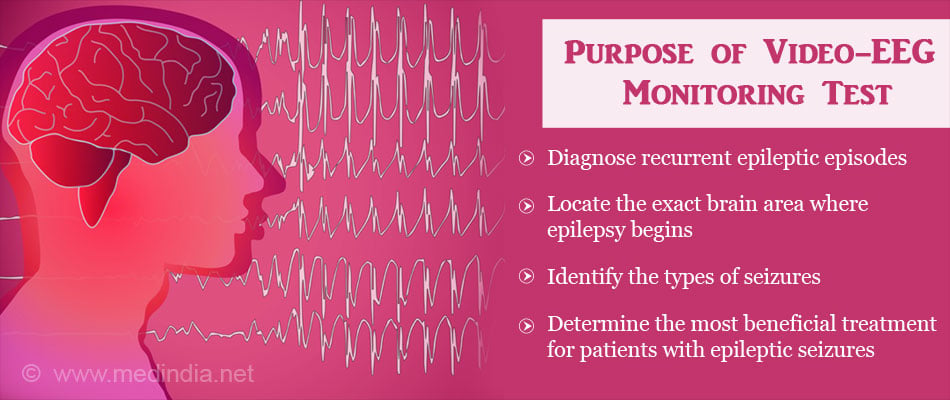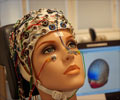- Clinical indications and diagnostic yield of video-electroencephalographic monitoring in patients with seizures and spells. - (https://www.ncbi.nlm.nih.gov/pubmed/12374255)
- Video EEG Monitoring Test (VEEG) - (https://uihc.org/health-library/video-eeg-monitoring-test-veeg)
- Video EEG monitoring - (http://www.rch.org.au/neurology/patient_information/video_eeg_monitoring/)
What is Video-EEG Monitoring Test?
Video-electroencephalography (EEG) monitoring is a diagnostic technique commonly used in patients with epileptic seizures.
Video-EEG Monitoring is also known as EEG telemetry or EEG monitoring.
Video-EEG is a non-invasive procedure, which records the electrical activity of the brain during seizures for a prolonged period (3 to 5 days) with simultaneous video recording. It also records the sounds made by the person during the testing period.
Video-EEG recording helps to locate the exact brain region where the seizures start and hence provides vital information that helps with both the diagnosis and treatment.
Prolonged video-EEG monitoring should be performed for any patient who continues to have frequent seizures attacks despite taking
Correlation between the recorded video and EEG activity can help the doctor to determine the accurate count of seizures and episodic events which may vary from time to time.
It is a gold standard diagnosis for psychogenic non-epileptic seizures (PNES), because video-EEG monitoring differentiates PNES and epileptic seizures using video analysis.
Video-EEG monitoring is an essential procedure that helps physicians to -
- Confirm the diagnoses of seizure disorders
- Classify seizure types
- Select patients who may benefit from surgery for epileptic seizures
What is the Difference between EEG and Video-EEG Monitoring?
Both the tests are similar as far as the recording of EEG is concerned.
What are the Types of Video-EEG Monitoring?
- Ambulatory EEG Monitoring
- Inpatient EEG Monitoring
Where is the Test Performed?
Video-EEG monitoring is performed in the Epilepsy Monitoring Unit (EMU). The patients should be admitted to the hospital for continuous monitoring. The length of the patient’s stay in the hospital will depend on the time needed to monitor seizure attacks (on an average the stay will be 3 to 5 days).
Ambulatory EEG Monitoring:
When video-EEG monitoring is performed in the home setting it is called ambulatory EEG monitoring.
The advantages of performing video-EEG at home are -
- It is less expensive than inpatient monitoring.
- Its ability to record continuously for up to 72 hours increases the chance of recording an ictal event or interictal epileptiform discharges.
- It captures the patient’s natural sleep pattern because most seizures and their symptoms occur at night times.
- Patients find it up to their satisfaction because the testing is performed in an environment comfortable to them.
Why is the Test Performed?
- To diagnose recurrent epileptic episodes
- To locate the exact brain area where epilepsy begins
- To identify the types of seizures
- To determine the most beneficial treatment for patients with epileptic seizures

What is the Preparation Required Before the Test?
- It is important to thoroughly wash the hair to reduce oil on the scalp for electrode application
- Wear comfortable clothing
- Keep a complete list of all your medications with you
- Do not use cell phones or other electronic equipment to avoid interfering with the EEG recording
- Long-term hospital stay may make the patient restless. So, it is better to keep them engaged with some activities like book reading
How is the Test Performed?
There are 2 main components used in video-EEG monitoring:
- EEG
- Video Recorder
EEG:
As with any routine EEG procedure, electrodes are placed on the scalp with the glue, and the head with electrodes is covered by a gauze dressing or cap.
EEG recording is monitored by a computer that records the patient’s seizures activity for a longer period of time (24-hour recording).
This recording allows the doctors to compare the EEG activity with the patient’s physical as well as mental behavior during the test.
During the monitoring, the doctors may lower seizure medication to make seizure attacks likely to occur or apply other seizure triggers like sleep deprivation techniques, exercise and flash lights and they may ask you to stay up late at night.
Video Recorder
A camera is used to visually record the patient's physical activities continuously at the same time the EEG is recording the brain activity.
Patients will be asked to sit on top of the bed, within camera view to capture good video recordings.
There is a TV monitor with a split screen in the patient's room. The screen shows the EEG on one side and the video recording on the other side. There is a connected monitor at the nurse's station which shows the same recording so that the patient can be monitored at all times.
Epilepsy doctors will review and evaluate the raw EEG with the video data in the epilepsy monitoring units.
A seizure button is given to the patients to press when they are about to have seizures. So, based on the pressed event, doctors will review the recording and give special attention when the seizures begin.
What are the Risks & Complications of Video-EEG Monitoring Test?
The video-EEG monitoring procedure is a safe and non invasive procedure.
Risks involve
Epileptic seizures may be triggered using some techniques like depriving the patient of sleep or withdrawing the use of antiepileptic drugs during the monitoring. These techniques will make the patients experience a high intensity of seizures, and it may lead to high risk of injuries due to uncontrollable mental behaviors like depression, psychosis, falls and aggressive behaviors.
During or after the seizures, patients may try to get out of bed or pull electrodes off from the head. It usually happens when a person is confused or unaware of what is going on. In these situations, the epilepsy team may recommend a seat belt to keep them from climbing out of bed, mitts on their hands or other safety measures.
What Happens after the Test?
- Once the test is done, the technicians will remove the electrodes from your scalp.
- You can wash off your hair after the test.
- Test results will be sent to the primary doctor. Your doctor will review the study reports and discuss them with you.








